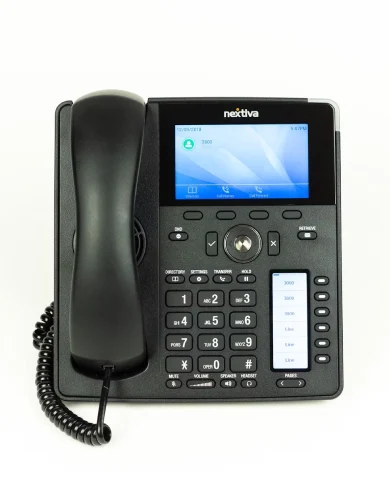Leased line installation
In the UK, the standard timeframe for installing a new dedicated leased line is around 90 days, regardless of your chosen provider.
Unlike other broadband services, switching leased line providers involves installing a new dedicated fibre optic cable.
This article explores the leased line installation process, explaining the factors involved in the timeline and addressing potential challenges to help you plan effectively.
💡Visit our page on how leased lines work for an explainer of this high-performance broadband technology.
The leased line installation process
Here, we’ll explain the five key steps in a leased line broadband installation and provide an estimated time frame for each.
Initial quote
Time-frame: 1–2 days
The quotation process for leased line installations involves a desktop review of the distance between a provider’s closest exchange and your commercial property.
Leased line providers use different exchange locations and adjust their proposed leased line broadband prices according to the required length of your dedicated fibre optic cable.
If you proceed with a quote, your provider will issue a leased line business broadband contract for your review and signature.
All leased line contracts are subject to a site survey. Where unforeseen additional costs are identified during installation, the provider retains the right to propose an Excess Construction Charge or cancel the agreement entirely.
💡 Use our business leased line comparison service today to quickly request quotes from our trusted panel of leased line providers.
Site survey
Timescale: 1-2 weeks.
Your business broadband provider will conduct a site survey to assess the feasibility of laying your dedicated bearer line (the fibre optic cable) from the exchange to your commercial property.
The site survey will evaluate:
- The requirement to obtain any wayleaves.
- The usability of existing fibre ducts between the exchange and your commercial property.
- The length and difficulty of any micro trenching required between the nearest duct and your commercial property.
- The Optical Network Terminal (ONT) position within your property.
If any unforeseen issues arise during the survey, your provider may propose an Excess Construction Charge. We’ve included a list of common problems below.
Assuming no unforeseen problems with your leased line installation, your provider will proceed directly to the infrastructure work.
Infrastructure work
Timescale: Minimum 1 month.
Your dedicated bearer line will be connected to the exchange and deployed through the underground ducting to your commercial property.
Where necessary, micro trenching will be used to connect the nearest fibre duct to the entry point of your commercial property.
A small hole is typically drilled in the wall of your property to allow access to the interior of the building.
Equipment installation
Timescale: 1-2 weeks
Your chosen business broadband provider will install an Optical Network Terminal (ONT) and a business broadband router, which connect to the terminating point of your dedicated leased line cable.
Network switches and mesh network equipment are typically not included in a leased line contract. It’s important for your IT team to consider the compatibility of existing hardware as part of the installation process.
Testing and go-live
Timescale: 1-2 weeks
Your provider will conduct testing to verify that your connection delivers the promised business broadband speed and latency performance.
Assuming these tests go smoothly, your leased line will be fully activated. Once your connection goes live, we recommend testing the performance against your agreed SLAs.
If your business requires additional speed, the installed bearer line can typically support a wider bandwidth. To scale your broadband, speak to the account manager at your leased line provider.
Delays with leased line installations
The following problems can result in significant delays, cost increases, or even the cancellation of a leased line installation.
Where these problems are identified, your leased line broadband provider may propose an Excess Construction Charge to cover additional costs.
Read on below for how to handle Excess Construction Charges.
Wayleave agreements
A wayleave agreement is a legal contract that grants a telecoms provider permission to lay fibre optic cables over, under, or on private property.
A common scenario where a wayleave is required arises when a business renting an upper floor of a building needs agreement from the building owner to lay a dedicated fibre cable through the lower floors.
When a wayleave is required, your leased line provider will draft a wayleave application and typically propose a standard set of rates for the wayleave rights.
Obtaining wayleaves can result in significant delays if the third party is unwilling or unable to agree to the proposed wayleave promptly.
Lack of useable fibre ducting
The bearer line will travel most of the distance through existing fibre ducting installed beneath roads in urban areas.
An initial leased line site survey will assess the usability of the ducts between the exchange and your commercial property.
If a duct is unusable or has yet to be constructed, a road closure will be required to build the new duct.
This will significantly increase both the cost of the leased line and the time required to complete the installation.
Handling Excess Construction Charges
Excess Construction Charges (ECCs) apply when the cost of installing a leased line exceeds what is covered under the standard installation fees.
An ECC typically arises when your provider needs to carry out additional work to bring connectivity to your premises in the following scenarios:
- Civil engineering work: Physical work such as trenching or roadworks is required to install the line.
- Infrastructure upgrades: Existing infrastructure (e.g., poles, ducts, or cabinets) needs to be upgraded or replaced.
- Custom routing: Specific routing is required to avoid obstacles, private land, or environmental concerns.
Where an Excess Construction Charge is required, your leased line broadband provider will quote the cost and require approval before proceeding with the installation.
If you are quoted an Excess Construction Charge, we recommend:
- Consider negotiating: Some providers may offer to share costs or waive ECCs on long-term leased line contracts.
- Consider alternative providers: Look for leased line providers with exchange locations that may eliminate the need for ECCs.
- Consider alternatives: Explore wireless leased line options or alternative business broadband deals if physical installation is prohibitively expensive.
SLAs for leased line installation
Some broadband providers offer a specific service level agreement (SLA) for leased line installation.
A typical SLA includes a committed delivery date set after the site survey. If the delivery date is not met, the provider may offer a percentage discount on the delivery charge.
We recommend enquiring about leased line installation SLAs when initially receiving quotes for a leased line business broadband service.
Preparation for a leased line installation
Our business broadband experts have three recommendations for preparing for a new dedicated leased line installation.
Negotiating wayleave agreements
If your property is leased or surrounded by private land, your leased line provider will likely need to negotiate a wayleave agreement.
We recommend communicating with your landlord early to explain the purpose and benefits of the leased line. This can help smooth the way for your leased line provider to conduct wayleave negotiations.
Identify access points
Designate a secure and accessible comms room for the leased line termination equipment. Ensure that the designated room has an adequate power supply and is well-ventilated.
We recommend clearing the comms room before the initial site survey and installation.
Plan for temporary connectivity
The leased line installation process typically takes 90 days but can take much longer if issues arise.
It’s important to plan for alternative connectivity during the installation process. Typical options include:
- SoGEA business broadband: Installations are usually quick as this service uses copper cables installed at most commercial properties.
- 5G business broadband: A 5G-enabled business broadband router can provide fast broadband without requiring physical installation.
- Full fibre business broadband: Rely on existing full fibre business broadband connections already installed on your property.
- Satellite business internet: Satellite broadband connections are universally available in the UK and require no physical installation.

